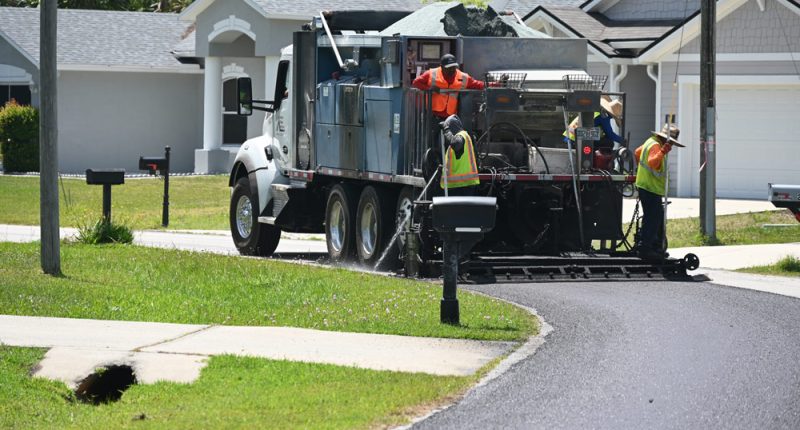
The Palm Coast City Council will seek at least a modest decrease in next year’s property tax rate when it adopts its budget in September, continuing a trend begun in 2021. It is not ruling out a full rollback in the tax rate, something the council has done only once in the city’s history, in 2023, at heavy cost to the city’s operations. The council resisted rolback last year.
Since 2021, Palm Coast’s property tax rate has been cut by 10.8 percent even as the general fund revenue the tax generates has increased by 53 percent, largely because of revenue generated by new construction, which has been explosive since 2018. For all that, the city has been straining from growth and limited dollars to carry out routine maintenance such as street paving or improvements to facilities like its aquatic center and Belle Terre Park, resorting to band-aid fixes.
Palm Coast’s current tax rate is $4.1893 per $1,000 in taxable value. In other words, a $200,000 house with a $50,000 tax exemption would pay $4.1893 (or 4.1893 mills) for every $1,000 in value, or $628. That’s just city taxes. The house would also pay county, school board and a few other, much smaller agencies’ taxes.
If the tax rate were reduced by another tenth of a mill, reducing the tax rate 13 percent since 2021, revenue would still increase 63 percent since then, based on current calculations.
“I would like to see what our budget would look like with a 10th of a rollback, at least,” City Council member Theresa Pontieri said at a workshop Tuesday after one in a series of budget presentations. The council is expected to set a tentative, maximum tax rate for next year before its September public hearings setting the final rate. Once it sets the tentative tax rate, commonly referred to as the “trim” rate (as in: truth in millage, a misnomer), it may not set a rate higher than that at the hearings, though it may go below the maximum rate.
A tenth of a mill cut is equivalent to just over $1 million in revenue. So if the current tax rate remains the same next year, it would generate $43.8 million, or $3.7 million more than this year. If it were cut by a tenth of a mill, it would generate $42.79 million.
“I know we’ve got some pretty big projects, things that the community wants, like the YMCA,” Pontieri said. The YMCA board is asking the city for a $3 million contribution to help build the $16 million, 44,000 square-ft. facility and swimming pool. It is planned for Town Center. “That type of stuff would have to come out of general fund revenues, maybe impact fees. We don’t have them in there right now, so we’d have to at least temporarily get them from somewhere.”
For most homesteaded taxpayers, property tax reductions have not affected their bills, though on occasion, residents addressing local governments will peddle the myth that their taxes have skyrocketed. That may be true for non-homesteaded properties, and for people moving into the state and paying a radically different tax bill on a house that was previously homesteaded.
But for the overwhelming majority of residents, property taxes have been flat for years, especially when other local governments’ tax rates are included: a steady decline in the school tax rate for the past 15 years has blunted any other local increase. In sum, a typical property owner today is paying roughly 30 percent less in property taxes than 10 years ago, when adjusted for inflation. As a result, property tax decreases have tended to have a more disproportionate ill effect on governments’ abilities to run their operations than a beneficial effect on a property owner’s bottom line.
Palm Coast is operating on a $422 million budget. Barely $40 million of that is property tax revenue–the revenue generated from your property taxes, and that goes into the $61 million general fund. Out of that fund, the city pays for police, fire, parks, streets, government operations (including those city council salaries some council members earn more than others), the Palm Harbor Golf Course, code enforcement and so on.
The balance of the city’s budget is made up mostly of autonomous funds generated by development impact fees and autonomous operations like the city’s water and sewer utility (which accounts for $155 million of the city’s budget), stormwater, garbage and building funds, and other operations. None of those are affected by property taxes or the property tax rate.
Both new construction and rising property values have fueled local government revenue. This year, the property appraiser is estimating an increase of 9.29 percent in taxable values. That doesn’t mean property owners will pay an additional 9.29 percent in taxes: under law, homesteaded property owners may not see their property tax bills increase by more than 3 percent (or the rate of inflation, whichever is lower) in any given year, assuming tax rates are unchanged.
Of the 9.29 percent increase in Palm Coast, 5.27 percent is attributable to new construction, so existing homeowners’ taxable value increase is smaller. At the current tax rate, the city would generate $43 million in revenue, an increase of $3.7 million. Of that, $2.1 million is attributable to new construction.
The difference between what is attributable to new construction and the balance of the increase is important because that difference–the $2.1 million–falls outside tax-increase calculations.
Under Florida law, if a local government’s tax rate stays the same year over year but that government’s revenue increases, that’s considered a tax increase. (It’s not logical, and in several regards it’s erroneous, but it’s the law.) For it not to be a tax increase, the government must adopt the so-called rolled-back tax rate–the rate that would generate the identical amount of revenue, year over year.
In all those calculations, tax revenue generated by the current year’s new construction is excluded, because it is net growth, separate from the existing tax base. Local officials often refer to revenue from new construction as “free money,” since the windfall would remain even if a government were to adopt the rolled back rate. So if the council were to adopt the tax rate that would generate the same $40.1 million revenue next year that the current rate generated this year, there would still be an additional $2.1 million in the general fund budget.










